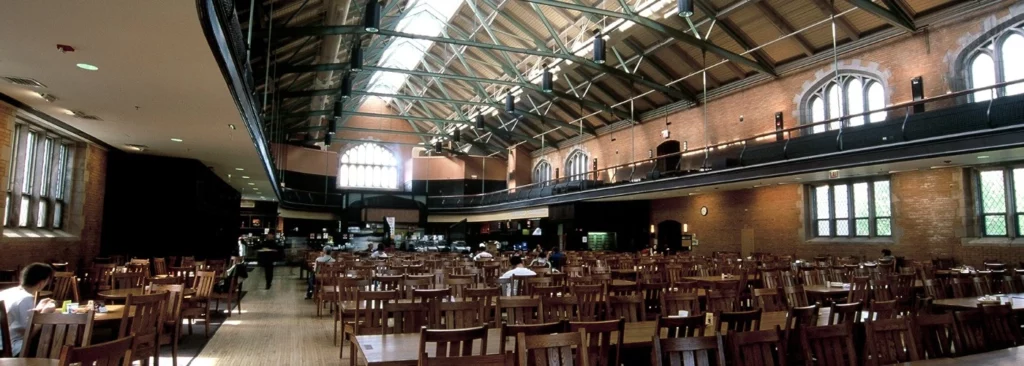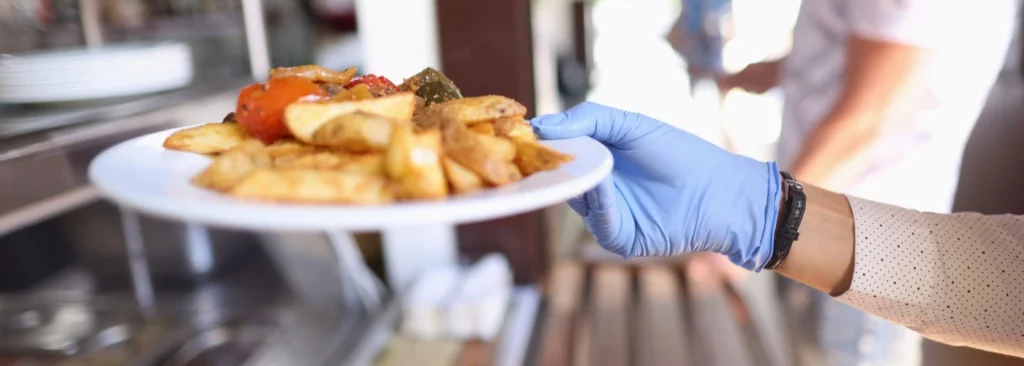
Providing a safe environment for college students and staff is a key priority for campuses and requires a multi-faceted security approach with an established set of protocols across various parts of campus life. A safe college community relies on the campus personnel that oversees, enforces, and implements the comprehensive practices. An important component to any overall college safety strategy is a food safety plan for onsite foodservice facilities.
Establishing and Implementing a Food Safety Plan
Food safety, the process that encompasses proper handling, preparation, storage, and serving of food that prevents foodborne illness, must be embraced by everyone working in foodservice facilities. Foodservice managers on college campuses have the important job of creating a food safety plan, hiring, and educating the right staff to implement it, including an extensive training program with regular testing and monitoring.
Ultimately, the entire foodservice team must be aware of all applicable food safety protocols to ensure a safe dining experience for students and staff. Below is an overview of the key elements of a thorough food safety plan, including best practices, to help ensure a safe dining environment.
Storing Food
It is important to follow the below tips for storing food safely to reduce the growth of foodborne bacteria and keep food fresh:
- Immediately refrigerate perishable foods.
- Label items with expiration dates and check dates regularly.
- Keep refrigerators at or below 40 degrees Fahrenheit, and freezers at or below zero degrees Fahrenheit.
- Follow storage directions on labels, and ensure ready-to-eat foods are still stored properly.
- Check for food that is emanating unusual smells and/or looks discolored.
- Marinate food in the refrigerator, and boil marinating liquids if they are going to be used as a sauce.
- Keep foods covered or sealed while they are being stored and check for damage to food containers.
- Store food away from chemical cleaners or other potential contaminants.
Preparing Food
- Sanitize your hands in addition to washing after handling raw meat
- Wash surfaces and utensils with hot soapy water
- Disinfect surfaces after preparing raw meat, and keep raw meats away from other food items during preparation
- Thoroughly rinse fruits and vegetables
- Wipe up any leftover materials and dispose of them in a garbage receptacle
- Use separate cutting boards for different types of food items
- Cook food items to the proper minimum internal temperature
- Thaw frozen foods in water, a refrigerator, or a microwave
Preparing Food

Campus dining halls can include table service, self-service stations or cafeteria attendant served areas. Some best practices for safely serving food for all types of service include:
- Always wash hands after bussing tables or doing cleaning tasks
- Avoid directly touching food items
- Keep water containers away from potential contaminants
- Always use an ice scoop
- Sanitize your hands after handling money or high-touch surfaces
- Keep hair pulled back and avoid touching one’s face
- Avoid touching the serving surfaces of dishware (e.g. the insides of glasses, the surface of dishes)
- Thoroughly wash hands for a minimum of 20 seconds with soap and water after using the bathroom or coming into contact with biological materials.
Managing Self-Servers

In many cases, assurance of food safety for self-serve stations comes down to common sense intervention as well as education for customers. Best practices for safely preparing and managing self-serve stations include:
- Regularly wiping down and sanitizing surfaces
- Ensuring clean serving utensils are available and regularly cycled out
- Providing instructional signage related to food safety at the station, and monitoring to ensure customers are responsibly using the station
- Ensuring dishware is clean
- Partitions are clean and in place
- Regularly cycling out food items and cleaning serving containers
- Keeping covers in place
- Informing customers to avoid touching food with bare hands
- Providing sanitizer or sanitizing wipes
Cleaning and Sanitizing
 Properly cleaning and sanitizing food contact surfaces has never been more vital. This includes staying stocked on products to clean surfaces — such as disinfecting wipes. It also means providing supplies to help diners to maintain personal hygiene including the placement of hand sanitizing wipes and handwashing stations conveniently throughout dining areas. Best practices include:
Properly cleaning and sanitizing food contact surfaces has never been more vital. This includes staying stocked on products to clean surfaces — such as disinfecting wipes. It also means providing supplies to help diners to maintain personal hygiene including the placement of hand sanitizing wipes and handwashing stations conveniently throughout dining areas. Best practices include:
- Thoroughly cleaning and sanitizing all food-contact surfaces including wiping down all stations
- Sanitizing high-touch surfaces
- Cleaning floor mats
- Cleaning vents and drains
- Taking out garbage
- Sweeping and mopping floors, and vacuuming carpeted areas
- Emptying rag buckets
- Collecting materials such as soiled aprons and rags for laundering
- Thoroughly cleaning appliances such as soda fountains and ice cream machines
- Cleaning any spills in the walk-in refrigerator
Preventing Cross-Contamination
Preventing cross-contamination with food is critical in ensuring a safe food service environment and requires a heightened level of cleaning. With nearly 48 million Americans experiencing a food-borne illness every year, campus food services must practice the following cleaning procedures to prevent contamination:
- Washing hands for at least twenty seconds with soap and water before and after handling food, and doing so again in between different types of food
- Thoroughly cleaning off food contact surfaces
- Scrubbing grease build-up from cooking surfaces in between cooking new meals
- Regularly cleaning the inside of the walk-in refrigerator
Best Practices for Regular Inspections
Just like any foodservice establishment, campus dining halls and cafes must comply with food safety regulations put forth by the FDA and USDA. In addition, many colleges have procedural standards unique to the institution and require third-party companies that serve food on campus to comply with these higher standards. All food services, including on-campus dining establishments, must undergo regular inspections as well.
The FDA may inspect your facility and also requires third-party inspections, for which you should prepare. However, conducting regular internal inspections are a useful practice as well, including these steps:
- Ensure employees are properly dressed and verify the use of gloves and hairnets
- Ensure food items are properly separated and stored
- Ensure preparation materials and appliances are properly cleaned
- Check the temperature of refrigerators and freezers
- Check expiration dates
- Review daily cleaning checklists for completion
- Ensure that handwashing protocols are being followed
- Ensure food contact surfaces, food storage, and high-contact surfaces are being properly cleaned
- Ensure items are being disposed of properly
- Check for any signs of pests
With the large numbers of diners, limited oversight around food stations, and substantial opportunities for cross-contamination, food service environments can be challenging to manage. The current COVID-19 pandemic creates additional complications with the risk of the spread of new highly contagious variants. However, an organized and experienced management team and a well-thought-out food safety strategy plan will help to ensure a safe and healthy experience for campus diners today, and in the future.
Sources:
- “Are you Storing Food Safely” The Food and Drug Administration 2021
- “Four Steps to Food Safety” Centers for Disease Control and Prevention 2022
- “Safe Temperature Chart” Food Safety and Inspection Service 2020
- “Food Safety Basics” North Dakota State University 2017
- “Prevent Cross-Contamination” Minnosota Department of Health 2007
- “Study Shows Most People are Spreading Dangerous Bacteria Around” Us Department of Agriculture 2018
- “Understanding Food Safety System” University of Maryland Extension 2021
“What Should I Expect During Inspection” The Food and Drug Administration 2020

